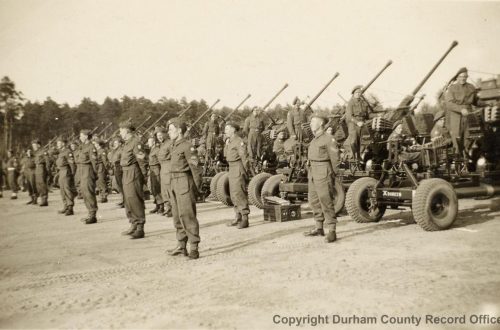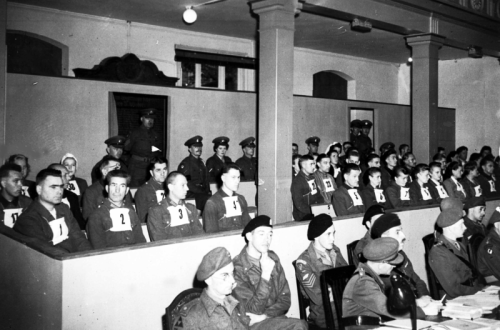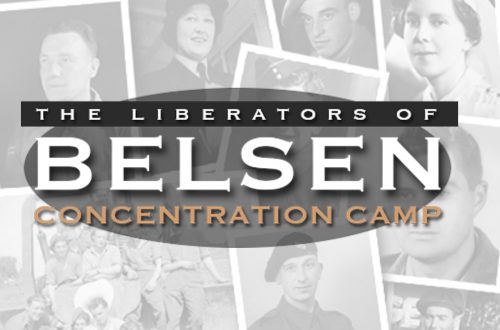Medical Report (Read with Caution)
Belsen Concentration Camp
Visited 22 Apr 45, 6 days after its capture by Second Army.
I was accompanied on my tour of inspection by RAMC officers who were engaged on relief work in the camp, and this constituted my authority for the few statements in this report which I cannot claim were the results of my own observations.
The camp contained 60,000 political prisoners, and this population consisted of men, women and children. They were of various nationalities; Russian, Polish, Dutch, French and to a small extent, German. Jews were in the majority, all were accommodated in huts.
It is obvious that the Germans did not intend that any of the prisoners should leave the camp alive, and the method of destruction which was chosen was death by very slow torture, i.e. By starvation. The rations given to the prisoners consisted of one cup of Swede soup a day, and one loaf of black bread for every twelve persons, per week. In addition to this, the Germans ensured that by the deliberate withholding of adequate sanitation, diseases such as dysentery, typhoid, typhus and tuberculosis, should become seriously prevalent, and in this latter object they were highly successful.
When they realised some weeks ago that the camp would be captured, the Germans ordered that no further burials would take place, and so there were found in the camp, lying singly, or in large or small heaps, no fewer than 18,000 corpses which had accumulated at the rate of 500 per day.
The first thing which I saw was the washing of women patients who had been brought to the camp by ambulance car to the German barracks adjoining the camp. It was a pitiful sight. The washing was done by German nurses who had been brought from elsewhere. The prisoners bodies were completely without fat, and muscle was negligible. Bones were on the point of breaking the skin, which in all cases was affected with bed sores, excoriations and disease. These women were completely helpless and screamed with pain as the nurses moved them.
It was almost impossible to assess the age of these women. Their hair had been cropped or cut very short, and they seemed little else but skeletons, clothed in skin. Their shrunken bodies, their shorn heads and the evidence of past and present suffering, made them all appear to be old. Their screams seemed to exhaust them. The contrast between them and the sleek and healthy German nurses who attended them, will not be easily forgotten. So light were these women that two were easily carried on one stretcher and there was still plenty of room. I visited the ward where the women were taken after being washed. The English Nursing Sister in charge spoke of the severe shock, which took 12 hours to show signs of abatement, in those patients who were expected to live. Here they were at least clean, and if they were to die, they would not die in filth.
An adequate description of the camp is difficult. It covers many acres and strewn through out the camp were naked, or semi-naked corpses. Sometimes singly, sometimes in heaps of a dozen, or forty or fifty. These mounds of bodies appeared to occasion no concern on the part of the prisoners; the sight had become to familiar. All these people had died by starvation, by preventable disease or both.
There was a huge pit 100yds long and 40yds wide, almost full of corpses, still unburied. I cannot give the depth of this pit, but there appeared to be about 100 corpses therein. It is not known how many hundred lay underneath those I saw.
Latrines, if they existed at all, were primitive, and prisoners of both sexes were seen defaecating anywhere and everywhere. I visited a hut full of women. They were lying in bunks, two or three lying in one bunk intended for one person. Some could smile and talk, others lay there moaning or silent. Two or three were defaecating into tins in the hut. Most of the women were too weak to leave their bunks, with the obvious results. The stench in the room was ghastly. None of the prisoners had had the opportunity or the strength to wash for weeks. Almost all showed the flush and bright eyes of fever.
Another hut contained some women who were even more ill and with them were the dead and dying. All were accommodated on mattresses, one inch thick. Those who were conscious moaned with pain or weakness. One of them held her hand for my attention. A finger was swollen to nearly its double size with a whitlow, and she begged me to help her. Her agony must have been intense and her condition was such that the simplest surgery could have prevented it. This woman had on her right side a corpse and on her left, one who was unconscious and on the point of dying. When I left this hut I asked to see the Hospital which the Germans provided for their sick women prisoners. I was told that this last hut was the hospital. It had less right to the title of hospital than anything I have ever seen.
In contrast to the prisoners who had been in the camp for months, or even years, there were those who had been fairly recently admitted. They were thin but they could walk and it was appalling to consider that the latter would inevitably would have become as the former, had the camp not been captured.
I was told that I had not seen the camp at its worst and that already there was an improvement. Although very many cases, including those suffering from Typhus, had been, and were being rescued from the camp by RAMC personnel, it was quite certain that many so rescued were beyond hope of recovery. I do not know the total deaths in the camp, but I do know that there are still hundreds of men and women yet to die. Solely as a result of their being prisoners in BELSEN.
23. April, 45. Army Medical Services
7,534 total views



